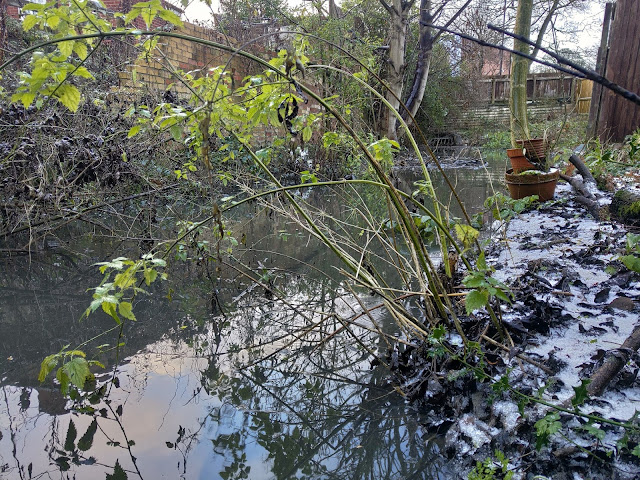The Edge Effect
We live beside the Wallsend Burn, a small river that divides the town more or less horizontally, and joins up with the Tyne a mile or two away at Willington Gut. That's why this blog is called 'Burn Edge', but it's also because one of my landscape preoccupations (along with mysterious steps and empty playing fields) is edges and boundaries, and what they offer or deny. The burn serves as the bottom boundary of our small sloping garden, and has come to represent one of the main ways I think about the geography of where I live.
Boundaries are of course a definining characteristic of any town. All land is parcelled and divided, owned and used to a greater or lesser extent. Here, the green corridor of the heritage trail is flanked by scrap metal merchants on one side and abandonded shipyards on the other. Gardens full of wildlife habitats abut others smothered in plastic grass. A river is both a boundary and a transgression, a chaotic element in the landscape. It's disrespectful of land ownership, linear but not straight, unpredictable and tidal. Rivers can be contained, however. Two gardens down from us, the burn is channelled under Station Road and the ex-servicemen's club, to emerge again in the deepening glacial valley at the centre of the Wallsend parks. Upstream, in the golf course, the river is dug out as a ditch and forced around a right angle, before passing through the allotments, and along to us. We collect golf balls in the little dam we've made. Sitting at the bottom of the garden on a summer's night would be a bucolic experience, if it weren't for the sounds of the 80s disco coming from the club over the road.
At the moment the culvert under the road is blocked, causing regular small floods in the gardens and the allotments. The Council become concerned only when the water threatens to rise up to road level. In the past I've pulled on my waders, armed myself with a spade, and dug out the blockage myself. It's quite an unnerving experience. The blockage itself is really more a kind of plug - a solid mass of branches, leaves and large litter items, held in place with thick, hardening mud. Lever parts of it away, and the water flow increases, pushing at you from behind. As I got stuck in with the spade, and as the newly-moistened mud schlucked through the opening, I began to imagine unpleasant scenarios - like being pinned to the horizontal bars, fresh detritus piling on top of me, or being sucked between them and journeying into the darkness under the road. I held my nerve and worked grimly at the plug for an hour or so, prising out the large blackened branches and flinging them further up the bank. Underneath it all, wedged firmly in the bars and bent out of shape, was our compost bin lid, which had mysteriously disappeared a few months before.
Most of the litter found in the burn comprises smaller items like cans and crisp packets. This year I dug some rough steps into the bankside so that we could collect water for the garden more easily, and every spade slice revealed fresh layers of accumulated rubbish - some of it fluttering away into the water before I had a chance to catch it. I now have quite a collection of nostalgic crisp packets. Forty years seems like a long time to us, but to a crisp packet its nothing. It's just the beginning of its long life on Earth. The packets that I couldn't catch will make their way down to the Tyne, and on into the sea, breaking down into smaller and smaller pieces as they enter the food chain. Living next to a river, I do feel a greater responsibility to pick up the litter I see - and I suppose I am (or would be) sternly critical of the kids who've chucked their rubbish in the burn over the years. But it's the corporations who produce this stuff who should take most of the blame. Nobody ever asked us if it was OK to introduce to the world these ugly little wrappers which outlive their usefulness many many times over. It was just another roll of the dice. Maybe if we'd known what it would end up meaning we would have said "No, that doesn't seem like a good idea." But, maybe we wouldn't.
If a river ends up becoming a receptacle for all kinds of human effluent, it also has pride of place in the centre of a town because it is useful and fruitful. It's a strip of abundance which can serve as irrigation, transport, wildlife corridor and green space. In our garden, I've planted water-loving trees like alder, willow and alder buckthorn, as well as town-tolerant trees like hawthorn and holly. At various times we see wrens, wagtails, long-tailed tits, kingfishers - and even moorhens and mallards when the level is up. The dam we built has the effect of slowing the flow of the river, increasing habitat diversity and injecting oxygen as the water tumbles over the rocks. The word 'burn', for a small river, is a Scottish and Northumbrian variant of the southern 'bourne', and both ultimately derive from the Proto-Indo-European 'bhreu' - to boil, bubble and effervesce. This is the life of the river, and really I'm happy for the garden to flood now and again, and to welcome the change of scene that comes with it. Permaculturalists talk alot about the edge effect - a transition point between two different forms of landscape or habitat which is often the most diverse and abundant part of the landscape. A river forms just such an edge - not only between earth and water (and water and air) but also between a strictly-parcelled human world and something wilder - and older.





Comments
Post a Comment